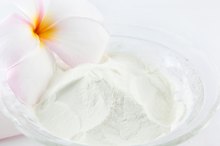L Tyrosine & Melanin
L-tyrosine is a chemical building block called an amino acid. Amino acids form the molecular foundation of proteins, a class of molecules upon which all life depends. Amino acids, however, also have their own individual and unique functions. L-tyrosine, specifically, supports the production of neurotransmitters, hormones and the pigment known as melanin.
Pigments
A pigment is a type of material that absorbs certain wavelengths of light and reflects others. The reflected wavelength is the one that you end up seeing. Pigments are pervasive in the photosynthetic processes of plants and certain industrial applications, but they are also important for producing color in animals. Melanin is the specific pigment that is responsible for the color of hair, skin and the iris of the eye. One of its primary functions is to protect the skin from sun damage and dissipate most of the UV radiation as heat. Because exposure to sunlight stimulates the production of vitamin D, however, high levels of melanin can be a risk factor for vitamin D deficiency.
- A pigment is a type of material that absorbs certain wavelengths of light and reflects others.
- One of its primary functions is to protect the skin from sun damage and dissipate most of the UV radiation as heat.
Melanin Production
Amino Acids to Produce Collagen
Learn More
Special cells known as melanocytes produce melanin in the outer layer of the skin. The concentration of melanocytes generally remains constant between individuals and ethnic groups, but the frequency of gene expression determines the amount of melanin instead. The greater expression of the gene creates an increase in the synthesis of melanin. Melanocytes are responsible for moles, freckles, suntans and, if they turn cancerous, melanoma.
- Special cells known as melanocytes produce melanin in the outer layer of the skin.
- Melanocytes are responsible for moles, freckles, suntans and, if they turn cancerous, melanoma.
Precursor
L-tyrosine is a precursor of melanin. This means that certain biochemical pathways convert L-tyrosine into melanin through the use of numerous "intermediate molecules" that are systematically modified into the end product. Genetic abnormalities and not dietary deficiency, however, are to blame for the insufficient production of melanin in the skin.
Dietary Sources
What Is the Difference Between L-Lysine & L-Tyrosine?
Learn More
L-tyrosine is a non-essential amino acid. This means that your body produces L-tyrosine and, subsequently, melanin from another amino acid known as phenylalanine. Tyrosine can still be found in a number of foods such as red meat, poultry, seafood, dairy, soy products, peanuts, almonds, avocados, bananas, lima beans and seeds. Though your body will always make all the tyrosine it needs independent of its consumption, you will still need to obtain phenylalanine from your diet, which you can find in most of the same foods. In the rare instance of a tyrosine deficiency, it is also available as a dietary supplement in capsule or tablet form. You should always talk to your doctor, however, before taking any additional supplements.
- L-tyrosine is a non-essential amino acid.
- Though your body will always make all the tyrosine it needs independent of its consumption, you will still need to obtain phenylalanine from your diet, which you can find in most of the same foods.









